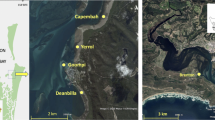Summary
The reoccupation of artificially cleared patches in a subtidal epifaunal community was investigated in two field experiments on the pilings of Edithburgh pier, South Austrlia. In most cases, the greatest proportion of the patch was reoccupied by the vegetative extension of established sponge and tunicate colonies adjacent to it. Larval recruitment by sponges, bryozoans, tunicates and serpulids contributed to the reoccupation but resulted in only a small proportion of the mean percentage cover. The relative abundances of individual species established in any patch were shown to be a function of the (1) position in space, (2) age, (3) time of creation, (4) initial size of the patch.
There was a large amount of between-patch variation in all cases. Overgrowth interactions occurred frequently within patches, and for many pairs of species, neither species consistently overgrew the other. Overgrowth interactions were tested statistically, and a large number of pairs of species were found to be competitively equivalent. This represents a possible situation additional to the alternatives recognized in the literature, namely competitive hierarchies or networks. Interactions between species should be regarded as stochastic, with a wide range of possible outcomes. The situation at Edithburgh is likely to produce greater between-patch variability than either a network or a hierarchy.
Despite this large variation, super-specific taxa differ fairly consistently in capacity for overgrowth. Tunicates overgrow sponges, which overgrow bryozoans, which overgrow serpulids. The occupation of most patches was directional in the sense that bryozoans and serpulids invaded first, but tunicates and sponges excluded them and came to dominate the patch. These realtionships are used to predict patterns of abundance for substrata which are small and isolated, and these predictions are compared with the epifauna of the bivalve Pinna bicolor, which provides such substrata adjacent to the pier.
Similar content being viewed by others
References
Buss LW (1979) Habitat selection, directional growth and spatial refuges: why colonial animals have more hiding places. In: G. Larwood and BR Rosen (eds) Biology and Systematics of Colonial Organisms. Academic Press, London and New York
Buss LW, Jackson JBC (1979) Competitive networks: non-transitive competitive relationships in cryptic coral reef environments. Amer Natur 113:223–234
Butler AJ, Brewster FJ (1979) Size distributions and growth of the fan-shell Pinna bicolor Gmelin (Mollusca: Eulamellibranchia) in South Australia. Aust J mar Freshwat Res 30:25–39
Connel JH (1978) Diversity in tropical rain forests and coral reefs. Science 199:1302–1310
Day RW (1977) The ecology of settling organisms on the coral reef at Heron Island, Queensland. Ph.D. thesis, University of Sydney, p 356
Dayton PK (1971) Competition, disturbance, and community organization: the provision and subsequent utilization of space in a rocky intertidal community. Ecol Monogr 41:351–389
Dayton PK (1975) Experimental evaluation of ecological dominance in a rocky intertidal algal community. Ecol Monogr 45:137–159
Grant WS (1977) High intertidal community organization on a rocky headland in Maine, U.S.A. Mar Biol 44:15–25
Harris J (1978) The ecology of marine epifaunal communities on the pilings of Portsea pier, Victoria. Honours thesis, Zoology Department University of Melbourne
Jackson JBC (1977a) Habitat area, colonization and development of epibenthic community structure. In: BF Keegan, PO Ceidigh and PJS Boaden (eds) Biology of benthic organisms Pergamon Press, Oxford, p 349–358
Jackson JBC (1977b) Competition on marine hard substrata: the adaptive significance of solitary and colonial strategies. Amer Natur 111:743–767
Jackson JBC (1979a) Morphological strategies of sessile animals. In: G Larwood and BR Rosen (eds) Biology and Systematics of Colonial Organisms. Academic Press, London and New York, p 499–555
Jackson JBC (1979b) Overgrowth competition between encrusting cheilostome ectoprocts in a Jamaican cryptic reef environment. J Anim Ecol 48:805–823
Karlson R (1978) Predation and space utilization patterns in a marine epifaunal community. J exp mar Biol Ecol 31:225–239
Kay AM (1980) The organization of sessile guilds on pier pilings. PhD thesis, University of Adelaide, p 239
Keough MJ, Butler AJ (1979) The role of asteroid predators in the organization of a sessile community on pier pilings. Mar Biol 51:167–177
Levin SA, Paine RT (1974) Disturbance, patch formation, and community structure. Proc Nat Acad Science 71:2744–2747
Osman RW (1977) The establishment and development of a marine epifaunal community. Ecol Monogr 47:37–63
Osman RW (1978) The influence of seasonality and stability on the species equilibrium. Ecology 59:383–399
Paine RT (1966) Food web complexity and species diversity. Amer Natur 100:65–75
Paine RT (1977) Controlled manipulations in the marine intertidal and their contributions to ecological theory. In: The changing scenes in natural sciences, Special publication No 12, Academy of Natural Sciences, p 245–270
Russ GR (1980) Effects of predation by fishes, competition, and structural complexity of the substratum on the establishment of a marine epifaunal community. J exp mar Biol Ecol 42:55–69
Schoener A (1974) Experimental zoogeography: colonization of marine mini-islands. Amer Natur 108:715–738
Siegel S (1956) Non-parametric statistics for the behavioural sciences, McGraw-Hill, New York, p 312
Sutherland JP (1974) Multiple stable points in natural communities. Amer Natur 108:859–872
Sutherland JP (1976) Life histories and the dynamics of fouling communities. In: Ecology of marine fouling communities, First USUSSR Workshop in the joint program of Biological Productivity of the World Oceans, p 137–153
Sutherland JP, Karlson RH (1977) Development and stability of the fouling community at Beaufort, North Carolina. Ecol Monogr 47:425–446
Wilkinson CR, Vacelet J (1979) Transplantation of marine sponges to different conditions of light and current. J exp mar Biol Ecol 37:91–104
Author information
Authors and Affiliations
Rights and permissions
About this article
Cite this article
Kay, A.M., Keough, M.J. Occupation of patches in the epifaunal communities on pier pilings and the bivalve Pinna bicolor at Edithburgh, South Australia. Oecologia 48, 123–130 (1981). https://doi.org/10.1007/BF00346998
Received:
Issue Date:
DOI: https://doi.org/10.1007/BF00346998




